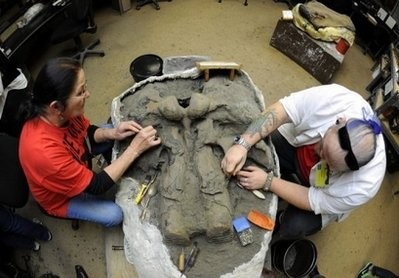LOS ANGELES (AFP) – Excited archeologists in California are rubbing their hands: after three years' back-breaking work they are finally, painstakingly revealing the face of Zed, the ice age mammoth.
Zed is the prize find in a fossil treasure trove unexpectedly unearthed at a Los Angeles building site in 2006, when workmen digging for a new parking lot stumbled on the prehistoric beast's skull.
"The Zed deposit was actually found by a bulldozer, by a piece of heavy equipment that took off the top six inches of his skull," said Trevor Valle of the Page Museum, which has meticulously cleaned some 80 percent of Zed's bones.
"But at least they stopped before they went any further. It was better to hit a somewhat simpler area of the head than say take out the teeth or the tusks," added Valle, scraping and cleaning away at the massive head bone.

In fact the primeval mammoth is only a tiny part of a huge haul of ancient bones and fossils found during work on the underground parking lot at the LA County Museum of Art (LACMA), in busy west Los Angeles.
Saber-toothed cats, giant jaguars and long-tailed weasels are among the thousands of animal remains found in the so-called La Brea Tar Pits, one of the world's most famous fossil sites.
The "Tar" refers to the highly viscous asphalt geological layer which helped preserve the fossils for so many millennia -- and in fact which caught many of the unsuspecting animals in its sticky embrace in the first place.
"It only takes an inch and a half to two inches to totally immobilize an animal the size of a horse," explained John Harris, the British chief curator of the Page Museum.
Animals which happened to step in it "got stuck like flies on flypaper. If they were lucky they would die of hunger and thirst in a few days. If they were unlucky they'd be torn apart by a saber-toothed cat," he added cheerily.
Once the workers had stumbled upon the fossils in the underground parking lot, they had to decide what to do with them.
Rather than stop building work, they decided to pack up all the bones into vast wooden crates, and take them to a nearby park, behind the Page Museum, where archeologists could sift through them at their leisure.
Collectively the trove of 10-40,000-year-old fossils from the Late Pleistocene period is known as "Project 23" -- after the number of timber boxes they are stored in.
The Page prides itself on being perhaps the only museum where people can see the sifters -- a small army of red-clad assistants crouched over in the boxes -- the cleaners like Valle in a glass-walled lab, and the finished displays, all in one place.
"People can come past and look through the fence and see excavators taking the fossils out of the ground," said Harris.
"Then they can walk across the park to the museum, and they can see the bones actually being prepared and cleaned, and being placed on display, so you get the whole experience," he added.
For Valle, a bear of a man covered with tattoos and sporting a colorful pony-tail, it couldn't be more exciting -- especially as he has worked on every single piece of Zed that has come out of the ground.
"It's just ridiculously cool. I'm cleaning a mammoth head, how neat is that?" he asks with Californian enthusiasm. "When we recover a fossil from them, we're the first humans to lay eyes on that animal."
So why the name Zed? It was chosen by Harris, as the British version of the last letter of the alphabet. "He's the last best mammoth we think we'll ever recover here, so Zed, Zee," said Valle.
But, he added, Zed may not be the last of it after all. "In fact there's a possibility that we may have a juvenile mammoth in one of the boxes, so we're starting the alphabet over, and we're going for 'Alfie'," he said.
























